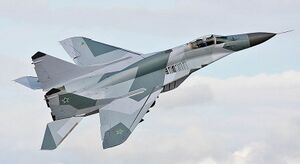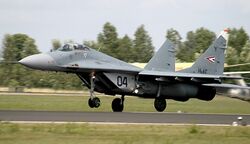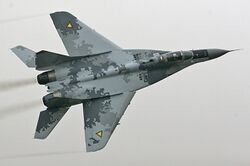AFASF-12 Drago Air Superiority Fighter
This article is incomplete because it is pending further input from participants, or it is a work-in-progress by one author. Please comment on this article's talk page to share your input, comments and questions. Note: To contribute to this article, you may need to seek help from the author(s) of this page. |
| Ersilia AFASF-12 Drago | |
|---|---|

| |
| An AFASF-12NG during the SAF international air show in 2018. | |
| Role | Air superiority fighter Multirole fighter |
| National origin | |
| Manufacturer | Ersilia Defense and Aeronautics |
| First flight | 3 May 1978 |
| Introduction | 11 February 1983 |
| Status | In active service |
| Primary user | |
| Produced | 1983—Present |
| Number built | 2,300+ |
| Unit cost |
ɫ20,500,000
|
| Variants | AFASF-12E AFASF-12A AFASF-12EA AFASF-12NG Drago II AFASF-12K |
The Ersilia AFASF-12 Drago (Dragon) is a single-seat, twin-engine jet fighter designed in Cacerta for the Cacertian Royal Air Fleet. Developed by Ersilia Defense and Aeronautics primarily as an air superiority fighter, it has served as the main air-to-air fighter aircraft of the Air Fleet since its introduction in 1983. They have been consistently upgraded since their introduction and currently feature improved engines, modern radar and IRST sensors, an increased fuel capacity, and HOTAS flight controls.
Although originally designed to fight enemy aircraft, they were later equipped with a range of air-to-surface and precision munitions. As air-to-air missions have become less prevalent in the modern era, many of the Dragos have undergone a refit that has allowed them to also serve as multirole fighters (Drago IIs), although the technical designation of AFASF-12 remains.
The Drago became a popular export aircraft since it’s introduction with purchases made by several nations throughout Tyran. It currently serves as the main air-superiority fighter of the Ruvelkan Imperial Air Force, the primary combat aircraft of the GASDF, and previously with the Æþurian Air Force. As of 2020, the Drago was still in production officially making it Ersilia’s most produced aircraft to date.
Development
Design
The AFASF-12 has an all-metal semi-monocoque fuselage possessing broad aerodynamic similarities to the earlier NSF-12 Albatro. It has mid-mounted swept wings with blended leading-edge root extensions swept at approximately 40°. A pair of tailplanes and vertical fins are mounted on booms outboard of the engines. Automatic, five-segmented slates are mounted on the leading of the wings with maneuvering flaps and wingtip ailerons mounted on the trailing edges. The boron-composite skin used in the construction of the Drago gives the aircraft very high heat resistance as well as exceptionally thin wing edges.
It was originally powered by a pair of EDA-78 turbofan engines with afterburners which are widely in comparison to its contemporaries; the space between the engines generates lift, reducing wing loading and improving maneuverability. Since 2010, most Dragos in Cacertian service have been upgraded to newer and significantly more fuel-efficient EDA-2010 turbofan engines. Both engines are fed by rectangular inlets equipped with variable intake ramps and, as an adaptation for rough-field operations, these ramps can be closed completely to prevent ingestion of ground debris. When the main intake ramps are closed, louvers on the upper fuselage are automatically opened and allow the engines to receive air through their auxiliary inlets.
The cockpit of the Drago is high-mounted and equipped with a bubble canopy that gives it increased visibility in comparison to previous Cacertian-designed fighters. The avionics systems includes a heads-up display, advanced radar, inertial guidance system, flight instruments, ultra high frequency communications, an advanced air navigation system, and instrument landing receivers.
An integrated helmet mounted display projects all essential fight information gathered by the integrated avionics and is visible to the pilot in any light condition. This allows operators to track and destroy enemy aircraft without the necessity of looking down at cockpit instruments.

The Drago is equipped with an advanced pulse-doppler radar that allows the aircraft to look up at high-flying targets as well as look-down at low-flying targets without confusing ground clutter. Despite the fact the Drago was more purposefully designed as a low-to-mid altitude dogfighter, it is equipped with radars capable of tracking targets beyond visual range.
The armament for a Drago often varies depending on its mission profile. As a dedicated air superiority fighter, this primarily focused on medium range air-to-air missiles, but as newer variants of the Drago were developed, this would later expand to also include multi-mission munitions. The Drago is equipped with eight external pylons, four under each wing. A single 30mm cannon with a 150-round magazine is located in the port wing root.
Since their introduction in 1983, the Drago has undergone a number of upgrades to improve performance and expand its capabilities. As of 2008, the majority of Dragos in service with the Cacertian Royal Air Fleet have been overhauled with newer hardware and sensors, which greatly increased a pilot’s situational awareness, as well as a new radar capable of provided instantaneous updates and enhanced multitarget tracking.
Dragos in Ruvelkan service saw extensive modifications and upgrades during their action in the Zemplen War. Designated AFASF-12Ks, the domestically developed Ruvelkan Dragos possess precision-guided targeting and an enhanced optical locator system that allows Ruvelkan Dragos to operate independently of ground-control interception. Among other upgrades, several Ruvelkan Dragos were later equipped with low-drag conformal fuel tanks which greatly increased their operational range for increased aerodynamic drag.
Operational History
Dragos have been involved in several modern conflicts since their introduction, first seeing action in Knichus during the FedCom Civil War primarily serving as combat escorts for Cacertian ground attack aircraft—they did not engage in direct air-to-air dogfights.
The first major deployment of Dragos in their intended combat role was during the short, six-day Imerti Conflict in which Ruvelkan Imperial Air Force Dragos fought several—though inconclusive—skirmishes against Syaran Zephyr fighters.
The Zemplen War saw Ruvelka’s air force pitted directly against the Commonality Air Force in the largest air-to-air conflict in modern history. As the main fighter aircraft of Ruvelka, the Drago's primary competition was the Syaran Zephyr.
While the Drago's maneuverability, especially within visual range, and higher speed gave it an edge in dog-fighting, early efforts at air-to-air combat were hampered by Ruvelkan reliance on pilot guidance by ground controllers. As Ruvelkan forces were forced to fall back throughout 2008, the loss of forward airbases and radar stations resulted in the Ruvelkan air force abandoning the ground guidance element and focusing on aerial command and control.
Taking advantage of their numerical superiority (although the CAF outnumbered the RIAF in total aircraft, the Ruvelkans fielded more fighters) Ruvelkan Drago Squadrons began employing a tactic called "kürt fészek" (hornet nest), avoiding one-on-one engagements with Syaran Zephyrs and forcing combat at close range to maximize their maneuverability. The Ruvelkans continuously refined and expanded their Drago fleet during the war, and their heavy usage of complex, rapid maneuvers earned the aircraft the nickname of "балерина" (ballerina) by Syaran pilots.
During the Arzell Crisis, the Imperial Shalumite Air Force placed their Dragos on standby although the resolution to the conflict came before they were sortied.
The Drago entered serialized production in Cacerta in 1983 and has remained in continuous production ever since. The original variant of the AFASF-12 ceased production in the mid-1990s, but the newer and upgraded variants for both Cacerta and its clients continues. With over 2,300 units produced between Cacerta and licensed nations, the Drago is one of the most produced air-superiority fighters in the region.
Variants
- AFASF-12
- The initial production version that entered service with the Royal Air Fleet in 1983. Following an upgrade and refit program (which resulted in the AFASF-12A) in the mid-1990s, only a handful of examples of the original version of the Drago currently exist, most of which are listed in the Air Fleet’s reserve or are preserved in museums.
- AFASF-12E
- The AFASF-12E (Esportazione) is the export variant of the original Drago. Many of the features remain the same between the original and the export, the only differences being a commercial variant, and not the Air Fleet standard, radar and electronic suite.
- AFASF-12A
- In 1993, Ersilia began a program designed to upgrade the systems of the Drago to modern standards and equipment; the final product was designated as the AFASF-12A (Aggiornamento). A number of flight control improvements provided better stability and controllability as well as an improved mechanical-hydraulic flight control system. The package also included a new radar and ECM system as well as the ability for the Drago to carry underwing and centerline drop tanks for increased range. The AFASF-12A was the first of the Drago family capable of engaging ground targets, although its overall focus was still air-to-air dominance.
- AFASF-12EA
- Ersilia offered a limited upgrade program to its export customers in 1998 following the success and release of the AFASF-12A designated as the AFASF-12EA (Esportazione Aggiornata). Many of the improvements that were installed on the As were included in the package, however the radar and electronic suits were once again commercial and not the Air Fleet’s standard.
- AFASF-12NG
- The lack of air-to-air engagements in the modern era resulted in the creation of the newer AFASF-12NG (Nuova Generazione). Originally, the NGs (later nicknamed Drago IIs) were simply further upgraded AFASF-12As with expanded ground attack capabilities. As of 2008, however, the AFASF-12NG entered its own serialized production and NGs that are now entering service are considered brand new aircraft.
- AFASF-12K
- The AFASF-12K (Korszerűsített) is a Ruvelkan-developed variant improving on the original AFASF-12EAs purchased from Cacerta. The aircrafts' performance during the Zemplen War affected further development of Ruvelka's air-superiority program and the native Ruvelkan design began deployment in late 2008. New precision-guided targeting capabilities and a uniquely designed optical locator system relieves the Ruvelkan AFASF-12EAs from their reliance on ground-control interception systems. These systems allow the AFASF-12K to conduct its missions independently.
Operators
Current Operators
 Cacerta; Cacertian Royal Air Fleet—776 in service as of September 2018. The Drago and newer Drago IIs form the backbone of the Air Fleet’s fighter inventory.
Cacerta; Cacertian Royal Air Fleet—776 in service as of September 2018. The Drago and newer Drago IIs form the backbone of the Air Fleet’s fighter inventory. Gylias; Gylian Air Self-Defense Force—32 AFASF-12EAs in service as of August 2018.
Gylias; Gylian Air Self-Defense Force—32 AFASF-12EAs in service as of August 2018. Knichus; Federal Commonwealth Air Force—24 in service across two squadrons.
Knichus; Federal Commonwealth Air Force—24 in service across two squadrons.Lirinya; Lirinyii Aerial Defense Force—The LADF operates 60 of the upgraded AFASF-12EAs.
 Ruvelka; Ruvelkan Imperial Air Force—The AFASF-12EA and the AFASF-12K are the primary air-superiority fighter of the Ruvelkan Imperial Air Force.
Ruvelka; Ruvelkan Imperial Air Force—The AFASF-12EA and the AFASF-12K are the primary air-superiority fighter of the Ruvelkan Imperial Air Force. Shalum; Imperial Shalumite Air Force—Entered service in 1990 as the ISAF’s primary air-superiority fighter; 100 units currently in inventory.
Shalum; Imperial Shalumite Air Force—Entered service in 1990 as the ISAF’s primary air-superiority fighter; 100 units currently in inventory.
Former Operators
 Æþurheim; URA Air Force—~200 units in service between 1983 and 1987. Placed into reserve and eventually sold.
Æþurheim; URA Air Force—~200 units in service between 1983 and 1987. Placed into reserve and eventually sold.
Specifications (AFASF-12NG)
General Characteristics
- Crew: 1
- Length: 17.37 m (57 ft)
- Wingspan: 11.4 m (37 ft 5 in)
- Height: 4.73 m (15 ft 6 in)
- Wing Area: 38 m² (409 ft²)
- Empty Weight: 13,380 kg (29,500 lbs)
- Loaded Weight: 19,200 kg (42,330 lbs)
- Max Takeoff Weight: 26,500 kg (58,420 lbs)
- Powerplant: 2 × EDA-2010 afterburning turbofans
- Fuel Capacity: 6,400 kg (14,109 lbs)
Performance
- Maximum Speed: Mach 2.25 (2,100 km/h, 1,310 mph) at altitude
- Cruise Speed: 1,960 km/h (1,220 mph)
- Service Ceiling: 16,200 m (>53,000 ft)
- Rate of Climb: 330 m/s (65,000 ft/min)
- Wing Loading: 442 kg/m² (90.5 lb/ft²)
- Thrust/Weight: 1.02
Armament
- Guns: 1 × 30 mm cannon with 150 rounds
- Payload: 5,500 kg (12,100 lb) on 8 external hardpoints (8 underwing)
See Also
- Aircraft of Comparable Role, Configuration, and Era



